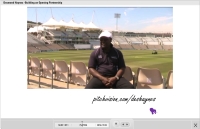Batting is Like a Good Night Out
Too many of us are guilty of the big Friday night out ahead of Saturday’s game; even professional players play the ‘rain card’, trying to decide if it will rain the next day in order to justify a night out in town.
But how is this for a justification for your ill behaviour: Going out is research because batting is just like a big night out on the town.
The first pint, the first ball
Batting Lion: The Desmond Haynes Masterclass is Available Now
 It’s a simple calculation:
It’s a simple calculation:Desmond Haynes was a world-class batsman. He is a world-class coach. The unique skills he can teach are invaluable to any player (or coach) with the desire to improve.
But you will never get to have coaching from him.
Desmond Haynes Video: Building a Partnership

This video is the 3rd free preview of the online coaching course Batting Lion: the Desmond Haynes Masterclass.
One of the secrets of success of the famous Greenidge-Haynes partnership was their working relationship. They were far more than the sum of their parts.
How to Chase a Batting Total like a Marathon Runner
Here’s a common problem; you are batting in a run chase and the rate is climbing. Your big hitter is back in the pavilion and you have always been more of a touch player.
Easy, think of the chase as less about a sprint and more about a marathon.
Chasing runs rates is just as much about pacing trying to finish it as quickly as possible.
2 Simple Ways to Innovate Without Switch Hit or Helicopter Shot
KP has the switch-hit, Dilshan has the Dil-scoop and Dhoni has the Helicopter shot. As club cricketers we can't use any of these high risk shots without looking foolish.
But this doesn’t mean us mere mortals can’t play any innovative shots to aid run rates.
While some of the more extreme shots are beyond us, we can all play shots outside the batting manual to implement lower risk shots that are still innovative.
Which Type of Slower Ball Works Best for You?
At club cricket the slower ball is Marmite.
People either love it or hate because there’s a thin line between bravery and stupidity. Deciding when to use a slower ball is subjective and relative to the situation.
I see most people (and I myself am guilty of this too) bowl a slower ball after they have been hit for a boundary as a comeback ball.
Why Roles Restrict Success
The slow scoring reliable opener, the hard hitting tail ender, the elegant stroke player, the strike bowler...
We label team mates to help determine their role in the side and to assist us in making decisions to best suit the situation.
Cricket Show 134: Selection Committee
| Attachment | Size |
|---|---|
| PitchVision Academy - PitchVision Academy Cricket Show 134.mp3 | 23.39 MB |
 The team’s attention turns to selection this week as we examine how modern sides decide on teams and succession planning (in the context of Australia taking on South Africa).
The team’s attention turns to selection this week as we examine how modern sides decide on teams and succession planning (in the context of Australia taking on South Africa).
Gary Palmer also returns to the show to continue his revealing interview on coaching batters at all levels.
And we answer your questions on captaincy while wicketkeeping and how to stop playing everything off the front foot when you bat.
How to Use Momentum to Win Cricket Matches
They say that winning is a habit. Unfortunately so is losing. But you can use momentum to carry your team into winning ways; one innings at a time.
So, momentum is a very real thing that we focus on during our games.
Imagine it, you win the toss and choose to bat.
After 30 overs you are restricted to 60-3 and your side are deflated by the prospect of setting just 130 to win.
With a few wickets in hand the batsmen stage a comeback and score a quick 150 off the next 20 overs.


